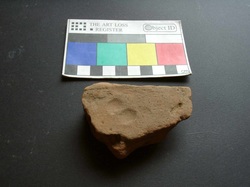
One aspect of a CM assemblage that is often reported is the presence of animal and human prints. This is a nice example of a dogprint from the Hunterian Museum via the BBC website. The comments include this:
I find this item fascinating because of the impressed footprint. I feel that this type of artefact brings us even closer to the people, or in this case the animals, of the past. I can imagine this dog may have been a beloved pet of a Roman or Scot or may have been a stray that wandered around the fort site for scraps.
I received Similar comments about the prints I used to illustrate my web report from Sagalassos. Indeed when I have given day schools there is often interest in these tracks from antiquity. There is a nice website showing examples of these prints set up by Will Higgs.
Among animals I have identified are cats dogs, sheep/ goats Donkeys and Cattle. Many other have been noted: from stoats to pigs. Human footprints are often made by a barefoot child or an adult in a hobnailed boot.
One aspect of my work is asking how many tile fragments have these prints on. Unfortunately for many sites there is currently no record of what was not retained, but I am getting together a reasonable database of groups from around the Roman world. Typically we are looking at less than 0.1% of an assemblage having animal prints, although this can vary from fabric to fabric and period to period as well as region to region. In Roman Britain there seems to be an increase un the number of tiles with animal prints after the third century. In Syria and Lebanon animal prints were very rare – most of what I have seen were on the bricks imported from Constantinople for the bathhouse BEY045. In Carthage there was a very specific local poorly made fabric The largest proportions of anial printed CBM I’ve seen is in Bulgaria. The number of prints from Sagalassos also suggest a high level of printing, but I need to undertake further work on quantified groups in order to establish the actual ratios.
So what does this mean? Well the obvious point is that whoever is producing these tiles is using a lot of space and the number of animal prints to my mind reflects a farm intermittently producing tile as one of many crops. In the Levant we are seeing CBM production of an industrial scale in the coastal Cilician region, with specialised tile manufactories so there are either no animals around or there is space to fence off. The tile drying area. In other places farm activities are more cheek by hoof as it were, with some damage to the Tile crop accepted as part of the payoff of not loosing the space during the tile manufacturing season.

 RSS Feed
RSS Feed
